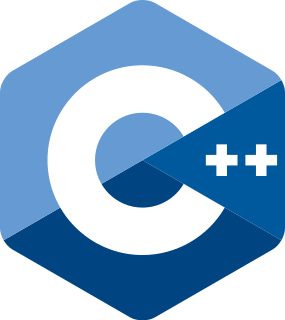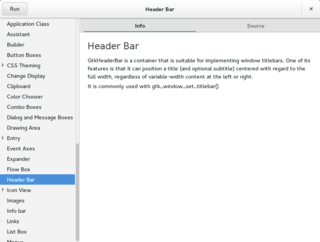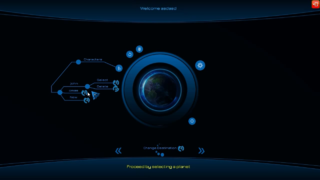This article needs additional citations for verification .(October 2012) (Learn how and when to remove this template message) |
 FLUID's code view window shows how the C++ output would look like if written on the disk. | |
| Stable release | 1.3.5 (March 3, 2019 [1] ) [±] |
|---|---|
| Preview release | 1.4.x-20190329-7a3af40e (March 29, 2019) [±] |
| Type | |
| License | GNU Lesser General Public Licence |
| Website | www |

FLUID (Fast Light User Interface Designer) is a graphical editor and GUI builder that is used to produce FLTK source code. FLUID edits and saves its state in text .fl files, which can be edited in a text editor for finer control over display and behavior. [2]
A graphical user interface builder, also known as GUI designer, is a software development tool that simplifies the creation of GUIs by allowing the designer to arrange graphical control elements using a drag-and-drop WYSIWYG editor. Without a GUI builder, a GUI must be built by manually specifying each widget's parameters in source-code, with no visual feedback until the program is run.

Fast Light Toolkit is a cross-platform widget library for graphical user interfaces (GUIs), developed by Bill Spitzak and others. Made to accommodate 3D graphics programming, it has an interface to OpenGL, but it is also suitable for general GUI programming.
In computing, source code is any collection of code, possibly with comments, written using a human-readable programming language, usually as plain text. The source code of a program is specially designed to facilitate the work of computer programmers, who specify the actions to be performed by a computer mostly by writing source code. The source code is often transformed by an assembler or compiler into binary machine code understood by the computer. The machine code might then be stored for execution at a later time. Alternatively, source code may be interpreted and thus immediately executed.
Contents
After designing the application, FLUID compiles the .fl file into a .cxx file, which defines all the objects from the .fl file, and an .h file, which declares all the global ones. [3] FLUID also supports localization of label strings using message files and the GNU gettext or POSIX catgets interfaces. [4]

In computing, internationalization and localization (AmE) or internationalisation and localisation (BrE) are means of adapting computer software to different languages, regional peculiarities and technical requirements of a target locale. Internationalization is the process of designing a software application so that it can be adapted to various languages and regions without engineering changes. Localization is the process of adapting internationalized software for a specific region or language by translating text and adding locale-specific components. Localization uses the infrastructure or flexibility provided by internationalization.

GNU is an operating system and an extensive collection of computer software. GNU is composed wholly of free software, most of which is licensed under the GNU Project's own General Public License (GPL).
In computing, gettext is an internationalization and localization system commonly used for writing multilingual programs on Unix-like computer operating systems. One of the main benefit of gettext is that it separates programming from translating. The most commonly used implementation of gettext is GNU gettext, released by the GNU Project in 1995. The runtime library is libintl. gettext provides an option to use different strings for any number of plural forms of nouns, but it has no support for grammatical gender.

A simple program can be made by putting all non-interface code (including a main function) into the .fl file, thus making the .cxx file a single source file to compile. Most programs are more complex than this, so other .cxx files can be written that call the FLUID functions. These .cxx files must #include the .h file, or they can #include the .cxx file so it still appears to be a single source file.
Normally the FLUID file defines one or more functions or classes, which output C++ code. Each function defines one or more FLTK windows, and all the widgets that go inside those windows.

C++ is a general-purpose programming language created by Bjarne Stroustrup as an extension of the C programming language, or "C with Classes". The language has expanded significantly over time, and modern C++ has object-oriented, generic, and functional features in addition to facilities for low-level memory manipulation. It is almost always implemented as a compiled language, and many vendors provide C++ compilers, including the Free Software Foundation, LLVM, Microsoft, Intel, Oracle, and IBM, so it is available on many platforms.
Widgets created by FLUID are "named", "complex named", or "unnamed". A named widget has a legal C++ variable identifier as its name (i.e. only alphanumeric and underscore), and is defined by a global variable or class member that will point at the widget after the function defining it is called. A complex named object has punctuation such as '.' or '->' or any other symbols in its name. In this case, FLUID assigns a pointer to the widget to the name, but does not attempt to declare it. This can be used to get the widgets into structures. An unnamed widget has a blank name and no pointer is stored.
Widgets may either call a named callback function that one writes in another source file, or one can supply a small piece of C++ source and FLUID will write a private callback function into the .cxx file.








